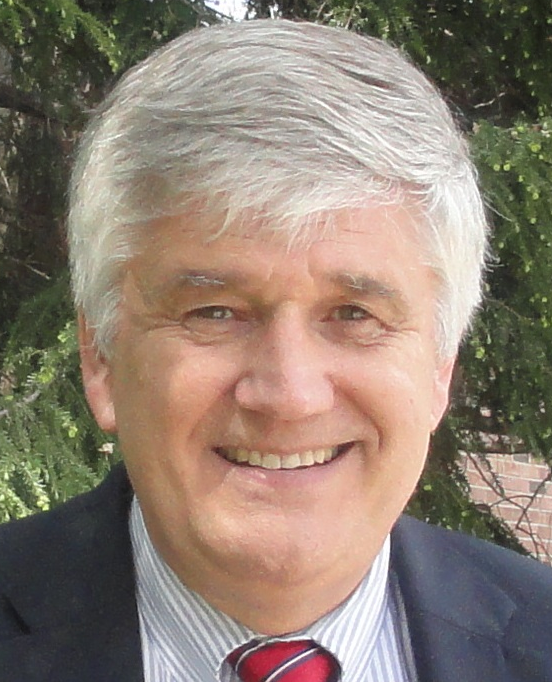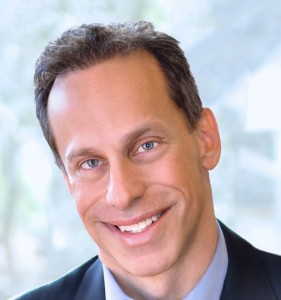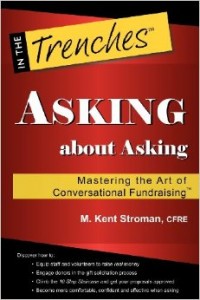Asking Matters at Events and Cool New Technology Makes That Easy
by Brian Saber
I’m not a huge fan of fundraising events but Valet.io makes me believe in them more!
I get the importance of events, but I’m not a party person. All the years I ran events as a fundraiser I wished I were sitting down with all those attendees individually instead (once a major gifts person, always a major gifts person I guess!).
And it frustrated me that silent and live auctions only engaged some of the attendees, when there were lots of other potential giving opportunities in the room. The time to capture it was that moment when the donor were revved up, having fun, and engaged.
Amazing new technology by Valet.io allows everyone to text their contributions from their smart phones and see the impact their giving is making in real time. I saw this technology firsthand at a recent fundraiser and it was wild. The politician finished speaking, the event chairs asked for additional gifts, and 60 seconds later the campaign was $5,000 richer!
Monitors tracked donations and totaled them so we could see how our gifts were adding up and that egged attendees to do more. We’re all fascinated by technology today. It was fun to figure out how to submit the pledge. I didn’t see a single person NOT pull out their phone!
Another benefit – no more deciphering handwriting or calling the next day to follow up. Founder Jake Silberg says, “Valet.io tracks pledges in real-time, allowing organizations to collect payments at the event via credit card or check.” How nice is that?
Asking matters, and I love how Valet.io pushes the boundaries of asking in real-time at events.
The Top 5 Things to Remember About Asking for Gifts
by Brian Saber
Lately, I’ve been busy asking for significant gifts for Northwestern Settlement in Chicago where I’m serving as their campaign consultant and manager. It’s great to be back in the field, doing frontline fundraising along with all our Asking Matters members and followers.
I’m reminded that asking for gifts can feel daunting even when you’ve been at it for 28 years, and I recently took some time to make a list of the top five things for me to remember.
 #1 There is no one right way to ask.
#1 There is no one right way to ask.
Ask in your own style and your authenticity will win the day.
No question – having developed the Asking Styles and knowing I’m a Kindred Spirit is huge. It validates the way I’ve asked all these years and gives me the confidence to keep doing it my way.
#2 You are only the messenger.
Whether or not someone makes a gift is not your responsibility.
This took me awhile to believe. But it is true. I can only open the door and engage the donor. If I tell a powerful story, treat the donor well, and follow up appropriately, I’ve done my job.
#3 Your main role is to ask questions that engage the donor and to listen.
Asking for the gift is important but only a sliver of the conversation.
When I finally looked at the conversation analytically, I was struck by how little time is actually spent talking about a gift. Most of it is spent learning about the donor and having a conversation about the organization or program. And if I learn a lot and lead a rich conversation, it’s very likely a great gift will follow.
Asking for the gift is important but only a sliver of the conversation.
#4 Asking for the meeting is the biggest ask.
Virtually no one will meet just to say “no.”
This one I’ve always believed, and it’s true. Every time, I state clearly that I want to meet to talk about a gift. No beating around the bush. Donors know what the agenda will be. And they’ll virtually never meet with me if they don’t intend to give something, as that’s as awkward for them as it is for me! So, if I get a meeting the only questions are “how much?” “for what?” and “when?”
#5 Focus on the vision and the impact.
Yes, you have immediate needs for your organization, but always put them in the context of the greater picture.
I keep asking myself “why?” Why expand the dining hall at camp? So that everyone can eat together. Why is that important? Because meals are a key socialization, team-building, and skills-development time at camp. Why is that important? Because camp is more than having fun. For the inner-city kids we serve, camp helps them develop the skills they need to be productive and independent members of society. Why is that important? Because it strengthens society and makes the world a better place in which to live.
So the next time you’re getting ready to meet a donor, remind yourself of these five things…and breathe!
Brian Saber
President
Asking Matters
Interview with Gary Bukowski
by Brian Saber
 Gary Bukowski is Vice President for Advancement at the Barber National Institute in Erie, PA. When he arrived in 2007, the Barber Institute’s individual giving program consisted of 1,625 donors contributing $374,863 towards the organization’s mission of helping children and adults with special needs. Through Gary’s strategic vision and persistent efforts to develop a greater focus on private philanthropy, the Barber Institute is proud to exceed their two-year, $1,000,000 Challenge ahead of schedule – as this fundraising effort comes to a close June 30th, the Barber Institute has received $1.4 million from 3,027 donors. Asking Matters President Brian Saber caught up with Gary to find out some of the ways in which he brought about this huge impact.
Gary Bukowski is Vice President for Advancement at the Barber National Institute in Erie, PA. When he arrived in 2007, the Barber Institute’s individual giving program consisted of 1,625 donors contributing $374,863 towards the organization’s mission of helping children and adults with special needs. Through Gary’s strategic vision and persistent efforts to develop a greater focus on private philanthropy, the Barber Institute is proud to exceed their two-year, $1,000,000 Challenge ahead of schedule – as this fundraising effort comes to a close June 30th, the Barber Institute has received $1.4 million from 3,027 donors. Asking Matters President Brian Saber caught up with Gary to find out some of the ways in which he brought about this huge impact.
Brian: What would you say are the three most significant ways in which you went about creating this culture of giving?
Gary: In our case we started with a five-year philanthropic vision statement that mapped out how we would increase annual giving and develop a strong annual fund, which hadn’t been in existence previously. We went after annual fund gifts like never before, and also put an emphasis on legacy giving by immediately creating the Dr. Gertrude A. Barber Legacy Society.
Brian: Who developed that plan?
Gary: The first year I tried to get a lot of the infrastructure in place. I knew from my past experience that there were things we needed in place to be successful. Then I came up with a vision statement, which was developed into a 5-year plan, and then shared that plan with our boards. I talked with our CEO, the board, and friends in the community, and I also brainstormed with our various constituencies to see what they needed and what was on their minds.
Second, in my first year here, I asked many of our staff and faculty members what they needed from our organization in order to really make a difference in the lives of those they were serving on a daily basis. Their requests were very modest, and our employees were amazed that I was actually asking them what they needed. I developed a wish list for the Barber Institute from those discussions.
Third, whenever I could, I went back in front of the Barber National Institute Board of Directors to share with them what was happening and what we were attempting. I also went in front of the Dr. Gertrude A. Barber Foundation Board of Directors to give them some new ideas and keep them informed of our progress.
Brian: Who else from the organization is out there asking with you and what type of training have you given them?
Gary: There are now some board members who are asking. We have had some basic training but there’s definitely room for more improvement. We first had to get them to one level, where we were meeting with them one-on-one and encouraging their engagement and “asking” involvement with the Barber Institute. We have board members who are opening doors, lending their names to introductory letters, and helping in other ways. So they’re being “trained” to be involved, but they haven’t received any formal training – we have room to grow.
Brian: Let’s talk a bit about Asking Styles and Asking Matters. You’re an experienced fundraiser and one of our biggest fans. I’m curious to hear a bit more about how the Asking Styles have affected you and the people you work with at the Barber Institute.
Gary: We started talking about Asking Styles last fall, and when the book* came out in January, I was very intrigued with what I read and what I learned through our discussions at Asking Matters. For someone who grew up in fundraising, there was always this stereotype in people’s minds as to what a fundraiser consists of. But what I’ve learned from this experience is that we can all be successful askers, even if we’re different in our styles and perceptions. Since I do some teaching, I have now incorporated the Asking Styles concepts when I teach. I tell everyone that they can ask and receive gifts for the good of their cause. They don’t have to fit any stereotypes, and askers can come in different styles. It also instilled more confidence in me – it opened up a fresh perspective for me. I’ve since tried to get everyone I know to go to the website and take the Assessment!
Brian: Well, Gary, that’s what we love to hear! Thanks for all your great work in our field, and best of luck!
Don’t Fear the Big Ask
by Brian Saber
I recently made what I referred to as “a big ask” and I was so excited to do so. A few people asked me if I was nervous about it or if I had any misgivings, and I could honestly say I didn’t. The same was not true for my asking partner, whose stomach was doing flips in the days leading up to the ask.
I know many people fear any and all asking, but I’ve noticed the fear is often proportional to how “big” they perceive the ask to be. Why is the thought of asking for “a lot of money” so concerning? Why do people often say: “I can’t ask for that much money”?
With all the mental hurdles I’ve had to get past as a fundraiser, asking for “a lot” of money was never one of them. And I think it’s because I make sure to see the gift relative to the donor’s capacity to give rather than my own.
The seven-figure gift I solicited last week was mind-blowingly big from my perspective. I will never (never say never, right?!) be able to make a gift of that magnitude. That gift is many, many times what I’ll earn this year – or have ever earned in any year.
For my donors, the situation is very different. They make gifts based on their wealth, not their income. They’ve been great savers and investors and now live off the income from the wealth and make gifts from the amassed wealth. So they’re drawing on a very different source of income than most of us, who give based on what we are currently earning.
But I think there’s a second point that drives me just as much. We often talk about how fundraising should be less transactional and more transformative. The truth of the matter is that we all have fiscal year-ends and have to meet our fundraising deadlines. And that means asking for lots of smaller or mid-sized gifts in the last quarter of the year. How often have we had to make dozens of calls to donors in June because they’re annual fund gifts of $500 or $1,000 or $5,000 haven’t come in? And those gifts often feel transactional to me.
What’s interesting to me about the “big” asks – whether they are mega, campaign-type gifts or very large annual asks – is they are more transformative and less transactional. When we run a $1 million non-profit and ask someone for $25,000, we can really talk about the impact that gift will have. Often that gift funds a program, a staff position, or something else very tangible.
At that same non-profit, a gift of $1,000 – though important and appreciated – is difficult to qualify or quantify in a convincing way. Of course we can talk about the impact the organization is making on its clients, and ask donors to help us have that impact, but it’s more difficult to set up the direct cause/effect. So. in fact, I find the smaller gifts more difficult to ask for precisely because it’s harder for me to talk transformationally about them!
Give me a “big ask” any day of the week!
Interview with Melanie Franklin Cohn, Exec Director, Staten Island Arts
by Brian Saber
 Brian Saber, President of Asking Matters, was engaged to lead a board training for Staten Island Arts on April 28, 2013. Post-training he interviewed their Executive Director, Melanie Franklin Cohn, to share how she decided to conduct a formal board training and how she’s making the most of it.
Brian Saber, President of Asking Matters, was engaged to lead a board training for Staten Island Arts on April 28, 2013. Post-training he interviewed their Executive Director, Melanie Franklin Cohn, to share how she decided to conduct a formal board training and how she’s making the most of it.
Brian: What led you to decide to invest the time and money in formal board training and where were you hoping it would have the most impact?
Melanie: I haven’t had any real formal training on development so I’ve been attending individual training over the past 5 years just to catch up. And through trial and error and trying different methods I found Asking Matters and the approach really works for me. The focus on the asker helps me fight off the anxiety that I have when I have to ask. And it helped me personally break through some barriers that I have been facing so it was an easy step to realize that what was helping me would also help my board. I started to realize that having some formal board training would have a really big impact.
Brian: Had your board had any formal fundraising training before that?
Melanie: This was the first training we had around making an ask since I joined. The board had some training about 8 years but they told me it wasn’t that helpful to them. It didn’t help them get to the next step. So I am really hoping that the way that we built the training it starts to empower them and they see themselves as partners — the staff and the board together bringing donors into the organization. Because I really think that having many hearts, many hands, having the passion is what brings success in a fundraising effort.
Brian: So when you went about training, I guess you had some buy-in already because they were asking for something like this? Did you need to run your plan by anyone, or where you able to make the decision on your own to invest the money and ask the board for their time. How did that happen?
Melanie: They needed buy-in, definitely, and the board really needed to be ready for this and to give up a Sunday to come and do it. The buy-in for this was a long process – I think it was at my first board meeting that I brought up the board’s role in fundraising and I was told “we are NOT a fundraising board” and I just calmly replied “but you should be”! And I left it at that and didn’t push it. But ever since then, I have approached the board and board meetings with this expectation. It hasn’t been pressure but it has been presented as this expectation. And I just keep it moving.
Brian: Did you run this by your board President or did you just say to your board: “I would like to do this. How you feel about this?” How did you actually make this happen?
Melanie: I first bounced the idea off a few board members who have been leaders of the organization. They were enthusiastic and sit on the Executive Board. Then I got buy-in from my Executive Board before taking it to the full board for discussion.
Brian: How do you follow-up? What is your next step so it is not a one-shot deal?
Melanie: We had an Executive Board meeting shortly after the training and we reviewed the experience and talked about what we would do next. They decided that taking time at the next board meeting to practice asking would be an important next step, so we are going to do that tomorrow night and then determine next steps as a group. Later this month we are having a cultivation event at an artist’s studio with workspace. We are having wine and cheese, there is no fee, and we are inviting people we think could be possible donors who board and staff identified together. Some of them are donors, some of them are people we would like to develop a relationship with, and some of them are potential board members that we have identified. We’ll be talking with people, and having a presentation about what we do and our plans for the future. And that is all part of the training that we did with you. It is kind of a way to individually start practicing some of the skills.
The Top Five Reasons to Train Your Board to Fundraise
by Brian Saber
This post was written by Brian Saber, Asking Matters President. Brian has spent his entire career ASKING for money for non-profits. From his early days as a student leader and telethon caller (!) to his six years in charge of major and principal gifts throughout the Midwest for Brandeis University, to his two stints as an executive director, every position involved significant face-to-face solicitation. And he is still honing that art today, cultivating and soliciting select major donors for various clients. With that perspective Brian created Asking Matters, a resource that all non-profits could afford.
I’ve been doing a lot of board fundraising training lately, including half-day off-sites with Staten Island Arts and JVS Detroit. This gave me a chance to think about why we train our boards to fundraise. Here are the top five:
 #1 Board members WANT to be trained and appreciate it when they are.
#1 Board members WANT to be trained and appreciate it when they are.
Talk about your “Aha Moment.” It’s easy to think in terms of how difficult it is to get your board together. But the logistics struggle in no way reflects their strong desire to learn and to help. Every time I train, board members are incredibly enthusiastic, have fantastic questions, and participate fully.
#2 Training=Education
Board trainings are wonderful opportunities to educate your board members. They’re a chance to have everyone re-embrace your mission, get comfortable with your case for support, and better understand your organization’s programs.
#3 Training leads to better board giving
Once your board has had fundraising training, board members have the tools not only to cultivate and solicit people in their circle of friends and associates, but to solicit each other. A board solicitation process led by your board rather than you and your staff will pay off in spades down the road.
You can’t ask people to practice what they don’t know how to do
#4 Training leads to practice
You can’t ask people to practice what they don’t know how to do. So if you don’t train them, no amount of role playing, one-one-one pep talks from staff, or similar efforts can have the impact you want.
#5 It’s unfair not to
We all have to stop expecting people to do their jobs without proper training and tools. A “board fundraising packet” is not a training – it’s just more information board members have to absorb. Everyone needs training to do their job well.
Two Points for the Shy and Introverted: Proof We Are Great Fundraisers
by Brian Saber
No one believes it when I say that I am shy or introverted. They see me socializing, are aware of my track record in fundraising, and assume that means I’m outgoing and extroverted. And part of that assumption comes from the negative connotations people have of the shy and introverted.
On the Asking Matters Asking Style Assessment, I am clearly a Kindred Spirit, one of the two introverted Asking Styles. Everyone thinks I will be a Rainmaker or Go-Getter, the two extroverted styles.
Now a great article by Susan Cain in The New York Times Sunday Review (Shyness: Evolutionary Tactic, June 26, 2011) highlights important research that sheds important light on this subject and gives those of us who are shy and/or introverted our due. Ms. Cain notes that shyness and introversion share an undervalued status in a world that prizes extroversion…”As a society, we prefer action to contemplation, risk-taking to heed-taking, certainty to doubt. Studies show that we rank fast and frequent talkers as more competent, likable and even smarter than slow ones.”
But interestingly, as she points out, shy and introverted people have been important leaders in our world and, in fact, if shyness and introversion were such detriments, wouldn’t we be extinct by now? So the shy and extroverted of the world must have some great survival techniques!
My Sitter-like Temperament Makes Me a Great Fundraiser
Well that technique comes from the “sitter-like temperament” which is associated with a predisposition to shyness and introversion. Researchers credit those with sitter-like temperaments as “careful and astute…tend to learn by observing instead of by acting.” They “digest information thoroughly,” “stay on task” and, most important to fundraising, have “a willingness to listen and implement other people’s ideas.”
Bingo! What is the number one rule in fundraising? Listen. Listen to your donors. Get to know them. Get to understand what they want and need. We shy or introverted fundraisers are GREAT at that! So we learn lots more about them than our more extroverted “rover” counterparts.
Let’s not forget the cardinal rule. Once you say “would you consider a gift of $X to ABC Organization,” you are supposed to stop talking and wait for a response. We sitters can do that well. We’re used to listening and waiting for a response.
So, fellow Kindred Spirits and our introverted partners, Mission Controllers, take heart and have renewed confidence that we “sitters” are naturally great fundraisers!
To read Susan Cain’s entire article, click here: Shyness: Evolutionary Tactic
SMARTASKS to Complement Asking Styles
by Brian Saber
Demont Associates has developed a fascinating system for categorizing donors – SMARTASKS. Just as Asking Matters encourages you to know your Asking Style and fundraise using that style, SMARTASKS encourages you know what type of donor you are soliciting and ask for a gift in a way that represents that type.
Demont Associates starts with Simple asks (“S”) – straight-forward asks for those whose primary characteristic is loyalty. These are the easy and most likely gifts. But what about Igniters, Newbies and Bargain Hunters. We all know prospects who have those characteristics, and Demont Associates describes why they should be asked for different types of gifts. For instance, an Igniter would most respond to a Component (“M”) ask – to be a part of a challenge or matching gift initiative. And a Newbie – someone new to the organization – should receive the Optional (“A”) ask – to support one of three different programs.
This is a great way for a sophisticated fundraising shop to think about its prospects and lay out the best asks. And when paired with our Asking Styles, you can create a very strategic plan for who should ask who for what!
Thanks to Robert Demont and his team for this great new framework. For the complete chart of SMARTASKS and the article in their recent newsletter, click here.
Book Review: Asking About Asking by Kent Stroman
by Brian Saber
I love it when a solid new book on asking hits the market, and Asking About Asking by Kent Stroman fits the bill. Asking is such a deep, nuanced topic, and Kent has taken the time to delve into every facet of asking in great detail.
This is an excellent book for those who have a solid background in asking and want to become top-notch fundraisers. Even after my 25 years of front-line fundraising, I picked up more than a handful of “practical tips,” as Kent calls them, and made numerous notes in the margins.
Kent makes clear to the reader that fundraising is about the conversation and the relationship. He talks about “confrontational fundraising” versus “conversational fundraising” in a way that will be indelibly etched in your mind. That’s something we at Asking Matters stress as well, but Kent goes into far greater detail about how those conversations build the relationship.
Much of the book is focused on cultivating prospects to become very large donors. He rightly points out that it is easier to get a few large donors than 1,000 small donors – though it might not seem that way at first. Bringing up Pareto’s Law, the 80/20 concept, he reminds us of how much wealth is concentrated at the top and that this translates to 20% of our donors providing 80% – or more – of our resources. It certainly underscores the need to focus on individual face-to-face solicitations and dovetails with Simone Joyaux‘s great recent piece in the Non-Profit Quarterly, “Hey Mr. Fundraiser….Stop Asking Your Board Members to Trespass.” She berates the field for forcing board members to provide lists of names and constantly pursue all their friends and relatives, trespassing on those relationships rather than identifying a few key people to cultivate.
Thanks, Kent, for adding a rich resource to the field.








